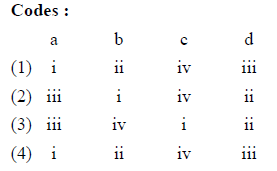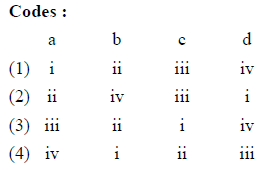COMPARATIVE STUDY OF RELIGIONS
PAPER – III
Note : This paper contains seventy five (75) objective type questions of two (2) marks each. All questions are compulsory.
1. Who was the father of Comparative Study of Religion ?
(1) Max Muller
(2) Mircea Eliade
(3) Max Arthur Macauliffe
(4) Max Weber
2. Identify the correct statement from the following :
(1) Tribal religions have special festivals.
(2) Tribal religions have their scripture.
(3) All tribal religions have apostles.
(4) Tribal religions have prophets.
3. The religion which does not believe in rebirth ?
(1) Buddhism
(2) Islam
(3) Sikhism
(4) Hinduism
4. Identify the false statement from the following :
(1) Religion is essence of life.
(2) Religion is useful for human life.
(3) Religion is harmful for human life.
(4) Religion is a need of Social life.
5. Which religion believes that salvation can be achieved only by taking birth as a human being and by practicing presence during this life :
(1) Judaism
(2) Jainism
(3) Christianity
(4) Islam
6. Book ‘Elementary forms of Religious Life’ was written by
(1) Emile Durkheim
(2) Max Weber
(3) Mircea Eliade
(4) E.B. Tylor
7. The author of ‘Sacred and Profane’ is
(1) Emile Durkheim
(2) Paul Ricoear
(3) E.B. Tylor
(4) Mircea Eliade
8. Religions of sematic tradition, believe in
(1) Brahma
(2) Arhat
(3) Many Gods
(4) One God
9. An interfaith dialougue does not lead to
(1) religious co-existence
(2) religious conflict
(3) religious peace
(4) religious harmony
10. The hymns of the Vedas are arranged into
(1) Savaiyas
(2) Dohās
(3) Kundalis
(4) Metres
11. The main theme of Vedic culture is
(1) Purusharth-Chatushtya
(2) Thervād
(3) Āryasatya
(4) Mahāvrata
12. A big number of deities is mentioned in the Vedas, this concept is related to
(1) Communism
(2) Monism
(3) Charvākism
(4) Polytheism
13. This is the sub-text of Sāmveda
(1) Dhanurveda
(2) Āyurveda
(3) Gandharvaveda
(4) Arthaveda
14. Following scriptures deal with law, Justice, punishment, property and family matters, these are
(1) Brāhmana scriptures
(2) Āranyak scriptures
(3) Smriti scriptures
(4) Upanishad scriptures
15. The number of Puranas is
(1) Twelve
(2) Eighteen
(3) Twenty
(4) Twenty five
16. Following this match is not correct
(1) Sānkhya – Yoga
(2) Nyāya – Vaisheshik
(3) Purvapaksha – Uttarpaksha
(4) Meemānsā – Mahābhārata
17. The main declaration of adwait concept is
(1) Brahm Satyam Jagat Mithyā
(2) Avidyānivrittih Mokshah
(3) Vāk Vai Brahm
(4) Satyameva Jayate
18. Rāmāyana and Mahābhārata are
(1) Novels
(2) Epics
(3) Champu Kāvyas
(4) Religious texts
19. Sant Kabirdāsa was related to
(1) Chitrakut
(2) Ayodhyā
(3) Vārānasi (Kāshi)
(4) Kankhal (Haridwār)
20. Ramakrishna Mission was founded by Swami Vivekanand, on
(1) 1st May, 1897
(2) 23rd October, 1889
(3) 10th January, 1888
(4) 4th April, 1899
21. Tirthañkara Neminātha attained Nirvāna at
(1) Pāvā
(2) Sammedaśikhara
(3) Ayodhyā
(4) Giranāra
22. ‘Satkhandāgama’ test relates to
(1) Mūrtipūjaka Śvetambara
(2) Digambara
(3) Sthānakavāsi
(4) Terāpantha Śvetambara
23. The name of the sixth Jaina Āgama text is
(1) Sthānānga
(2) Vipākasūtra
(3) Upāsakadasānga
(4) Nāyādhammakahā
24. The author of ‘Pañcāstikāya’ is
(1) Samantabhadra
(2) Kundakunda
(3) Haribhadrasūri
(4) Pūjyapāda
25. According to Jainism the other name of ‘Syādvāda’ is
(1) Anekantavāda
(2) Saptabhangi Siddhanta
(3) Cāturyamdharma
(4) Triratna
26. According to Jainism the ‘Ākāśa’ is included in the group of
(1) Four Dānas
(2) Twelve Anupreksās
(3) Seven fundamentals
(4) Six substances
27. The supreme aim of Jainism is
(1) Practicing of meditation
(2) Attainment of wisdom
(3) Attainment of Salvation
(4) Purification of mind
28. The word Mūlasangha’ is associated with the
(1) Sthānakavāsi
(2) Terāpantha Śvetambara
(3) Digambaras
(4) Mūrtipūjaka Śvetambara
29. The author of Gommatasāra text is
(1) Ācārya Vidyānanda
(2) Ācārya Umāswati
(3) Ācārya Kundakunda
(4) Ācārya Nemicandra
30. ‘Research Institute of Prakrit Jainology and Ahimsā’ is running at
(1) Patna
(2) Vaishali
(3) Darbhanga
(4) Nalanda
31. Earliest Jaina image of Saraswati is found at
(1) Bikaner
(2) Mathura
(3) Pallu
(4) Ladnun
32. The name of Siddhārtha’s birth place was
(1) Kapilavathhu (Kapilavastu)
(2) Sāvatthi
(3) Lumbini
(4) Vesāli
33. The number of Mahābhūta-s (basic elements) recognized by the Buddhists is
(1) Eight
(2) Six
(3) Five
(4) Four
34. The language in which the Vaipulya Sūtra-s were complimented later written in
(1) Pali
(2) Prakrit
(3) Sanskrit
(4) Buddhist Hybrid Sanskrit
35. Sarvāstivāda is basically related with
(1) Theravāda
(2) Mahāyāna
(3) Mahāsanghika
(4) Vetullanvāda
36. The Vibhajjavāda is supposed to be related with
(1) Theravāda
(2) Sarvāstivāda
(3) Śūnyavāda
(4) Vijñavāda
37. The famous Sanchi Stupa is located in the State known as
(1) Uttar Pradesh
(2) Bihar
(3) Madhya Pradesh
(4) Maharashtra
38. The leader of the Buddhist team which propagated first in Sri Lanka was
(1) Bhikkhu Mahinda
(2) Bhikkhu Mahānāma
(3) Bhikkhu Ittiya
(4) Bhikkhu Uttiya
39. The ancient Buddhist University at Nalanda in Bihar was named as
(1) Nava Nalanda Mahāvihāra
(2) Nalanda Vidyāpitha
(3) Nalanda Viśvavidyālaya
(4) Nalanda Mahāvihāra
40. The Sarvāstivāda Āgama (collection of the Buddha words in Sarvāstivāda Sect) is lost in its original farm, but available in its translated from in
(1) Tibetan language
(2) Mongolian language
(3) Sinhalese language
(4) Chinese language
41. Which among the following order of the varnas was acceptable to the early Buddhists ?
(1) Sudda (Śūdra), Vessa (Vaiśya), Khattiya and Brahmana
(2) Vessa, Khattiya, Brāhmana and Sudda
(3) Khattiya, Brāhmana, Vessa and Sudda
(4) Brāhmana, Khattiya, Vessa and Sudda
42. Dr. B.R. Ambedkar selected the 10th day of the Bright fortnight of Ā.svina month as the day to embrace Buddhism. This day is popularly known as Vijaya Dasami . To Ambedkar it was the day of victory of
(1) Lord Ram
(2) Lord Krishna
(3) Maratha Sardar Shivaji
(4) King Ashoka
43. Jesus was born at
(1) Bethlehem
(2) Nazareth
(3) Jerusalem
(4) Jericho
44. Protestant Reformation was started by
(1) Karl Barth
(2) Martin Luther
(3) St. Ambrose
(4) St. Augustine
45. Which is the branch of Christian theology that relates to environment ?
(1) Eco-theology
(2) Liberation theology
(3) Natural theology
(4) Reformation theology
46. The immediate forerunner of Jesus Christ is
(1) John the Baptist
(2) St. Elizabeth
(3) St. Joseph
(4) St. Mary
47. Identify the correct group according to the chronological order of the persons of the Bible.
(1) Jacob, Abraham, Isaac, Jesus Christ.
(2) Abraham, Isaac, Jacob, Jesus Christ.
(3) Isaac, Abraham, Jesus Christ, Jacob
(4) Jesus Christ, Jacob, Isaac, Abraham
48. Among the apostles of Jesus, who was martyred in India ?
(1) St. Thomas
(2) St. Francis
(3) St. Mathew
(4) St. Chavara Kuriakose
49. The author of “confessions” is
(1) Karl Rahner
(2) Joseph Ratzinger
(3) St. Thomas Aquinas
(4) St. Augustine
50. Read the List-I and List-II and identify the correct answer in the code given below :


51. Christianity does not believe in
(1) Trimity
(2) Rebrith
(3) Resurrection
(4) Original Sin
52. Identify the correct match from the following lists :


53. The 1st book of the Old Testament is
(1) Psalms
(2) Ezra
(3) Genesis
(4) Jonah
54. At the age of 12, Muhammad accompanied his uncle, Abu Talib on a caravan journey to Syria and met a Christian monk named
(1) Alexander
(2) Jhon
(3) Bahira
(4) William
55. The word Quran means
(1) Recitation
(2) Wisdom
(3) Rhyme
(4) Rhetoric
56. The party which supported the fourth Caliph Hazrat Ali and believed in the Divine right of rule was known as
(1) The Aristocrats
(2) The Emigrants
(3) The Supporters
(4) The Legitimists
57. The statement “Arabia had to conquer itself before it could conquer the world” reference to
(1) Conquest of Mecca
(2) Ridda wars
(3) Battle of Jamal
(4) Battle of Sifin
58. Cyprus an important Byzantine maritime naval base was captured by Mu’awiyah in the year
(1) 635 A.D.
(2) 630 A.D.
(3) 640 A.D.
(4) 649 A.D.
59. The earliest Philosophical School of thought in Islam was
(1) The Asharites
(2) The Mutazilites
(3) The Qdarites
(4) The Khārijites
60. Vasco da Gama landed at Calicut in the year
(1) 1498
(2) 1598
(3) 1698
(4) 1798
61. Identify the correct answer and mark the same in the given below :


62. Which of the following statement is correct ?
(1) The concept of Pan-Islamism was given by Mohd. Abduh.
(2) Ibn Battuta was a musician.
(3) Abu Muslim Khurasani was an Arab.
(4) The Mutazilite school of Muslim philosophy was established by Wasil bin Ata.
63. Which of the following is correct chronologically ?
(1) Khiljis – Mughals – Tughluqs – Ghaznawivs.
(2) Abu Bakr – Ali – Umar – Uthman
(3) Judaism – Islam – Christanity – Zoroastranism.
(4) Meccca – Madina – Damascus – Baghdad – The capitals of Muslim States.
64. Ibn al-Arabi was the author of
(1) Ihya al-uloom
(2) Fusus al-Hikam
(3) Kitabi- Nauras
(4) Awrif al-Maarif
65. Identify the correct match from List-I and List-II.


66. Identify the correct match from List-I and List-II.


67. Guru Nanak Dev refused to wear Janev because
(1) It was a Hindu ritual.
(2) It could easily got burnt.
(3) It lost the spirit behind it.
(4) A thread could easily broken.
68. Pransangali granth was brought to Amritsar from
(1) Kartarpur
(2) Sri Lanka
(3) Tibet
(4) Hasan Abdal
69. Author of Twarikh Guru Khalsa is
(1) Giani Gian Singh
(2) Kesar Singh Chhiber
(3) Sarup Dass Bhalla
(4) Ratan Singh Bhangu
70. Rehatnamah means
(1) Letter of Guru Gobind Singh
(2) Hukam of Guru Granth
(3) Sikh way of life
(4) None amongst above
71. First resident of British at Lahore was
(1) Lord Dalhousie
(2) Lord Hardingue
(3) John Lawerence
(4) Henry Lawerence
72. Maharaja Ranjit Singh won Lahore in
(1) 1708
(2) 1799
(3) 1699
(4) 1805
73. Dewan Mohkam Chand was
(1) An army general of M. Ranjit Singh
(2) Treasurer of Sarkar Khalsa
(3) Son of Dewan Kaura Mal
(4) Advisor of Dost Mohammad
74. At the occasion of Coronation Bahadur Shah honoured Guru Gobind singh at
(1) Hyderabad
(2) Delhi
(3) Agra
(4) Lahore
75. In America first Sikh group settled at
(1) Berkelay
(2) Stockton
(3) New York
(4) Bakersfield
Latest Govt Job & Exam Updates: